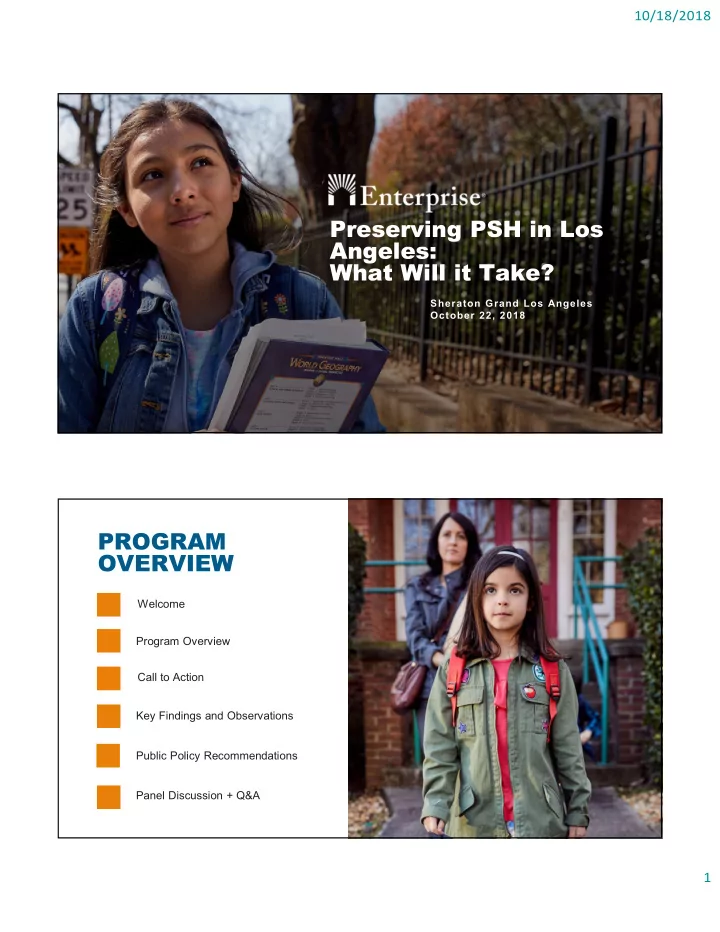

10/18/2018 Preserving PSH in Los Angeles: What Will it Take? Sheraton Grand Los Angeles October 22, 2018 1 PROGRAM OVERVIEW Welcome Program Overview Call to Action Key Findings and Observations Public Policy Recommendations Panel Discussion + Q&A 2 1
10/18/2018 Call to Action: Why Does it Matter? Extend Affordability Quality of System Life for Scaling Residents PSH Preservation Mission- driven Improve Cash Flow Owner Capacity Physical Needs 3 Los Angeles PSH Preservation Initiative 4 2
10/18/2018 Barriers: How Did We Get Here? Physical Financial Policy 5 Key Findings and Observations 6 3
10/18/2018 Key Findings: • 1,300 units identified as at-risk across workgroup • 75% of projects are at breakeven operations or worse • Median original construction date = 1928 • 62% are Single Room Occupancy (SRO) units • 97% of projects have HCID or CRA financing; 33% with State HCD • Oldest PSH buildings are concentrated geographically • City of Los Angeles: CD 14 (39%) and CD 13 (21%) • County of Los Angeles: SD 1 (42%) and SD 3 (46%) • 300+ units lack project-based rental assistance • 300+ units set to expire in next 5 years • Nearly ½ of units required less than $20K/unit St. Mark's Hotel, Skid Row Housing Trust 7 Project Distribution (by City Council District) 8 4
10/18/2018 Project Distribution (by Supervisorial District) 9 Project Distribution (by Service Planning Area) 10 5
10/18/2018 Financial Health (by Projects) 11 Total Rehab Cost (per unit) 50 45 40 35 Percent of Units 30 25 20 15 10 5 0 $20,000 or less $20-000 - $35,000 $35,000 - $50,000 $50,000 - $100,000 $100,000+ Rehab Cost 12 6
10/18/2018 Public Policy Recommendations 13 What Have We Learned? • PSH is a unique model to create, operate, and sustain • 25% of workgroup portfolio is at-risk • Capacity building grants have been critical tools • Financial impact of serving high-acuity still unknown • RAD candidates exist but limited experience in the sector • Existing financial tools can’t respond to diversity of need; not all projects will need resyndication • Resyndications are complicated, like two deals in one • Opportunity to coordinate resource and policy decisions across jurisdictions 14 7
10/18/2018 Recommendations PSH Preservation Mitigate Operating Set Cost Priorities Escalations Protect Funder Expiring Alignment Covenants Modify Rent Dedicate or Subsidies Prioritize Capital 15 Where Are We Going? • Expand risk assessment – what else is out there? • Cultivate learning from grants and early resyndication projects • Advocate for dedicated capital source (e.g., Linkage Fee) • Partner with HCID to set initial priorities (e.g. SROs) • Engage funders and stakeholders across CA • HCID experience is instructive, focused on modernizing agreements, but has limits: • Extending covenants and loans (making co-terminous) • Conducting CASP assessments • Asset management fees • Social services cost allowances • Modifying reserve requirements • Restructuring cash flow distributions • Coordinate with City, County, and State to align funder policies. 16 8
10/18/2018 Panel Discussion 17 THANK YOU 18 9
Recommend
More recommend